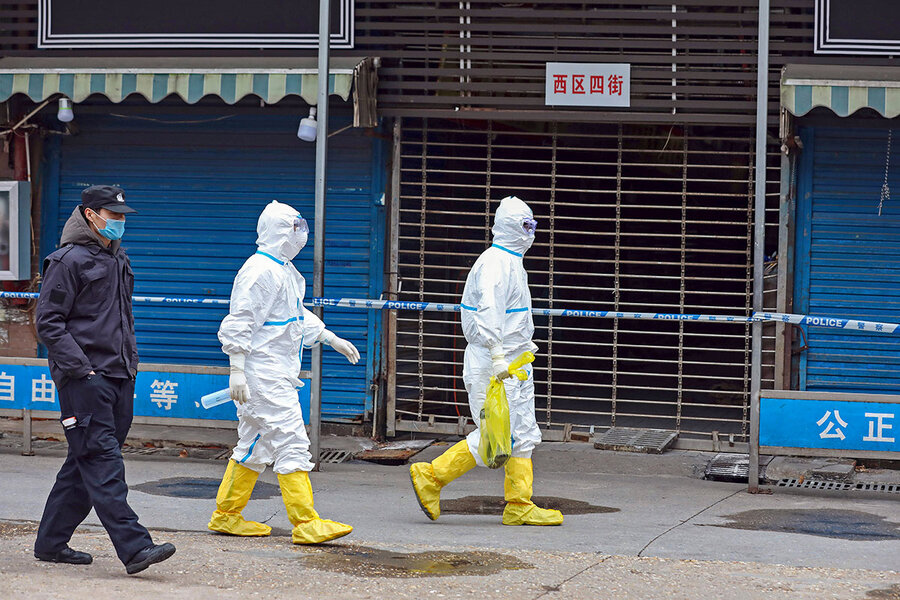Coronavirus outbreak: Three questions on China’s response
When coronavirus first started dominating global headlines, it quickly raised alarm – but maybe not surprise. Every decade or so, a major outbreak has come out of China, from the 1957 Asian flu to the SARS epidemic in 2003.
Why is that? It’s hard to say – and worth keeping in mind that other parts of the world have also experienced outbreaks in recent years, such as the 2009 swine flu pandemic that started in Mexico, and the MERS coronavirus that originated in Saudi Arabia in 2012. Many Chinese at home and abroad have raised concern about increased bias since this outbreak came to light.
Here’s a look at how China’s top-down politics plays into public health, as well as what Beijing and the rest of the world are doing to stem the tide.
Why We Wrote This
Outbreaks create fear – not just of disease, but sometimes of the places they originate and the people who live there. Taking a step back gives some perspective on China’s crisis.
Why does China see so many outbreaks?
Contributing factors include sheer demographics. China’s huge population of 1.4 billion includes nearly 30 of the world’s 100 most populous cities. Adding to this is the close proximity of city and farm dwellers and animals. Chinese leader Xi Jinping criticized the “bad habit” of eating wild animals as “a major hidden danger to public health” and ordered a crackdown on illegal wildlife markets that Chinese researchers have identified as a source of virus transmission.
Beijing’s tight grip on media also plays a role. Chinese authorities were slow to publicize the threat to their own public. “Information could have been shared with the public earlier in ways that would have helped reduce the probability of the virus spreading so far and so fast,” says Jeremy Lee Wallace, an associate professor at Cornell University who researches authoritarian politics and China. Early on, doctors drawing attention to the problem were accused of “rumormongering,” and two bloggers writing about the virus have disappeared. Observers have also noted that regional officials may have been reluctant to share bad news with Beijing.
Two months into the outbreak, how is China responding?
Beijing has acted far more quickly in informing the international community about the current outbreak than it did during the SARS epidemic, experts say, despite censorship within China. In 2003, “there was a lot of secrecy” and “a long delay in China notifying internationally,” says Ann Marie Kimball, a physician and epidemiologist who led the APEC Emerging Infections Network at the time. In contrast, this time China’s health authorities announced the discovery of the coronavirus and within a week had published the genomic sequence, “so all around the world countries could begin to understand it,” says Dr. Kimball, now a senior fellow at the Center on Global Health Security at Chatham House. “China has demonstrated an incredible technological depth.”
But experts question the effectiveness of China’s massive lockdown and quarantine of Wuhan, a city of 11 million. Concentrating people in large facilities risks worsening the spread, especially as critical supplies are running short. “The containment strategy is going to be very challenging for them to be successful with,” says Dr. Kimball.
How can the rest of the world help?
Governments, foundations, and international organizations are pouring hundreds of millions of dollars into the fight. The U.S. government has pledged up to $100 million to help China and other affected countries, and has facilitated the transport of more than 17 tons of masks, respirators, and other supplies to China. Meanwhile, the Bill & Melinda Gates Foundation is donating up to $100 million to improve detection, isolation, and treatment efforts, says Jeff Hall, a deputy director at the foundation.
Nevertheless, China was slow to grant access to experts from the World Health Organization, approving a 12-member team for arrival in mid-February.
“Whether humanitarian actors will be allowed to go in and provide the type of support that is usually needed in a potential humanitarian crisis of this magnitude remains to be seen,” says Gabrielle Fitzgerald, founder and CEO of Panorama, a Seattle-based “action tank,” who has worked on combating Ebola and malaria. “China has really closed themselves off to everyone … but obviously if the situation gets significantly worse they may need to admit they need help and call on other actors to support them.”






